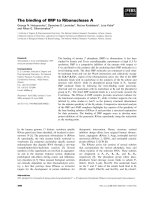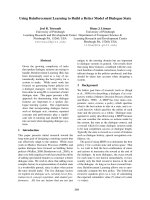Effects of stereoscopic 3D contents on the process of learning to build a handmade PC
Bạn đang xem bản rút gọn của tài liệu. Xem và tải ngay bản đầy đủ của tài liệu tại đây (724.33 KB, 16 trang )
Knowledge Management & E-Learning: An International Journal, Vol.3, No.3.
Effects of Stereoscopic 3D Contents on the Process of
Learning to Build a Handmade PC
Aika Mukai
Fujitsu Hokuriku Systems Limited
3-4-30, Masuizumi, Kanazawa-City, Ishikawa, Japan
E-mail:
Yoshio Yamagishi*
Department of Media Informatics
Kanazawa Institute of Technology
3-2, Yatsukaho, Hakusan-City, Ishikawa, Japan
E-mail:
Makoto J. Hirayama
Department of Media Informatics
Kanazawa Institute of Technology
3-2 Yatsukaho, Hakusan-City, Ishikawa, Japan
E-mail:
Toshiya Tsuruoka
Hokuriku Software Development Co., Ltd.
4-81-3, Yoneizumi-Town, Kanazawa-City, Ishikawa, Japan
E-mail:
Tosh Yamamoto
Division of Teaching and Learning
Kansai University
3-3-35, Yamate-Town, Suita-City, Osaka, Japan
E-mail:
*Corresponding author
Abstract: We previously developed Web3D contents that simulate the
procedure for assembling a handmade PC. The original motivation for this
project was to enable media-informatics students to deepen their understanding
of PC hardware. However, it was found that due to their lack of perspective,
conveying information that relates to such virtual manufacturing was quite
difficult using conventional 2D displays. In this study, we optimized the
graphical contents for a stereoscopic environment that would allow proper
perspective to be realized. No significant differences were identified between
stereoscopic 3D cases and 2D cases. This result is considered to be due to
491
492
Mukai, A. et al. (2011)
learner fatigue specific to stereoscopic 3D cases.
Keywords: Stereoscopy; 3D Modelling; PC Assembly; Interactive Simulation
Biographical notes: Aika Mukai is currently on the staff of Fujitsu Hokuriku
Systems Limited, Japan. She earned her M.Eng. in System Design Engineering
from Graduate School, Kanazawa Institute of Technology. Her master thesis is
based on this work.
Yoshio Yamagishi is currently an Associate Professor in the Department of
Media Informatics, Kanazawa Institute of Technology. In 1996, He received
his D.S. degree in Theoretical Physics from Graduate School, Kanazawa
University, Japan. Current his research interests include e-Learning System
Design, Mobile Learning and 3D Computer Graphics.
Makoto J. Hirayama, Doctor in Engineering is a professor in the Department
of Media Informatics, Kanazawa Institute of Technology. He researches into
multimodal and multimedia communication technologies for e-Learning,
entertainment and well-being systems.
Toshiya Tsuruoka is currently on the staff of Hokuriku Software Development
Co., LTD., Japan. In 2008, He graduated from Department of Media
Informatics, Kanazawa Institute of Technology. This work is partially based on
his graduation thesis.
Tosh Yamamoto, Ph.D. is a professor in the Division of Teaching and Learning,
Kansai University. He has been active in the area of e-Learning specialized in
interactivity in e-Learning that brings learning effectiveness. He has been
researching on how to design a robust e-Portfolio system in the higher
education.
1. Introduction
Learning from experience is one of the traditional approaches for the education (Kolb,
Rubin, & McIntyre, 1974; Holman, Pavlica, & Thorpe, 1997). Especially in science and
engineering education, laboratory experiments, outdoor observations, physical activities,
designing and constructing usually yield better comprehension to students than classroom
lectures. In addition, repetitive practice is needed for developing some technical skills.
However, due to the issues of resources, such experience-based learning environments
are hardly acceptable for some educational organizations. Multimedia learning (Moreno
& Mayer, 1999; Mayer 2001) is the reasonable alternative. Multimedia interactive
learning contents can provide virtual experiences in the situated learning. Hirayama
(2010) showed that the role playing in augmented reality space is effective to language
learning.
Recently produced stereoscopic 3D movies, such as “Avatar” (2009) and “Alice
in Wonderland”(2010), have attracted considerable attention. These movies provided a
new and fascinating experience to audiences wearing 3D glasses. A common observation
was that people became addicted to Avatar to the extent that they experienced severe
depression after watching the movie (Piazza, 2010). It is expected that stereoscopic 3D
TV sets and PCs will become more common in the near future. Considering these facts,
we are certain that stereoscopic 3D technology will play an important role in a future
Knowledge Management & E-Learning: An International Journal, Vol.3, No.3.
493
media, and will also affect the field of education. In fact, the application of stereoscopic
3D technology to education has already begun (Pang et al., 2006).
Stereoscopic 3D environments are expected to be superior to conventional 2D’s in
the representation of spatial objects such as molecular structures, architectural
constructions and machineries. However, currently there are few actual examples of
stereoscopic 3D contents for the academic classes. The difference between 2D and 3D in
learning effects is still unclear. Similarly, the constructional method of the stereoscopic
3D learning environment is not common. In this paper we report the details of
stereoscopic 3D learning contents that we developed, and then discuss the learning
effects of the contents.
The beginning of our study is as follows. In the Department of Media-Informatics
of Kanazawa Institute of Technology, students are required to build a handmade PC for a
course titled “Major Lab/Exercise II.”. This exercise considerably helps to deepen
students’ understanding of PC hardware. However, due to space and budgetary
constraints, each group as opposed to each student is assigned one PC. Therefore, after
each student has completed the PC assembly, he/she disassembles it for another student
to repeat the same procedure. This must be repeated four or five times (depending on the
number of persons in the group). As a result, it appeared to be a waste of time.
The presence of learning contents that can be used to simulate the virtual
assembly of a handmade PC can provide an environment for students to experience PC
assembly at any time regardless of their location. Yamagishi and Tsuruoka (2009)
developed such contents by using Web3D. However, operation of the virtual assembly
tool was found to be difficult using a conventional 2D display because of the lack of
perspective. Therefore, in order to realize proper perspective, we plan to adapt our
contents to fit stereoscopic 3D environments.
2. Preliminary Work
In this section, we briefly review our preliminary work. The usual procedure for
assembling is as follows:
(1)
Insert the memory module into the slot of the motherboard
(2)
Insert the CPU into the socket of the motherboard
(3)
Place the CPU cooler on the CPU
(4)
Connect the power cable of the CPU cooler to the motherboard
(5)
Set the HDD into the case
(6)
Connect the SATA cable from HDD to the motherboard
(7)
Set the optical drive into the case
(8)
Connect a SATA cable from optical drive to the motherboard
(9)
Set a power unit into the case
(10)
Connect cables of the power line from the power unit to the motherboard, HDD
and optical drive
Note that the insertion of the CPU, memory module, and cables requires correct positions
and directions. Incorrect assembly will cause serious damage to the parts.
494
Mukai, A. et al. (2011)
In early 2008, Tsuruoka and Yamagishi began developing Web3D contents that
are capable of simulating the assembly of general IBM PC compatibles. The first step to
simulating the above procedure in a virtual 3D world involves the preparation of 3D
models for all PC parts such as CPU and motherboard.
2.1. Object Modeling
Figures 1 and 2 show a part of the process of modeling the contents. The software
LightWave 3D (Newtek Inc., 1994) was used to build almost all PC parts. During the
modeling process, we attempted to minimize each object’s polygons in order to reduce
the file size of the contents, because these objects must be converted into the Web3D
format and subsequently transferred over network. However, the quality of these models
was retained in order to allow the object to be easily identified. This trade-off was one of
the more challenging aspects of this project.
Figure 1. Modeling Process using LightWave 3D
Figure 2. Examples of Virtual PC Parts
2.2. Web3D Conversion
Web3D (Web3D Consortium, 1999) originated with Virtual Reality Modeling Language
(VRML), which is an early trial aimed at realizing 3D virtual world on the web. The
Knowledge Management & E-Learning: An International Journal, Vol.3, No.3.
495
“Metaverse” such as SecondLife (Linden Lab, 2003) is partially based on the Web3D
technologies. Quite a few trials to apply Metaverse or Web3D to the education have been
done so far (for example, Mohler, 2000; Cerbo, Dodero, & Papeleo, 2010; Lee & Berge,
2011).
Currently, there are numerous Web3D formats such as X3D (Web3D Consortium,
1999), Viewpoint (Viewpoint Corporation, 2000), and Cult3D (Cycore System AB,
1997). Majority of them have resulted in improved quality and realism when compared
with the old VRML. In this study, we chose the ShockWave 3D (Macromedia Inc., 2001)
format, which was developed by Macromedia Inc. (a part of Adobe Systems Inc. since
2005). The major reason for choosing ShockWave 3D (SW3D) is the existence of the
LINGO language, which can easily extend the function of SW3D contents.
The conversion of LightwWave 3D objects into the SW3D format requires them
to be exported in a w3d format and then imported into a Macromedia Director, which is a
major authoring tool for ShockWave contents. Using Director, we incorporated some
special features such as object movement, rotation, or contact judgment in a LINGO
manner.
2.3. Operation
We show an example screen shot of our contents in Figure 3. This picture explains the
method of memory module insertion into the motherboard. The instruction is written in
Japanese at the lower left. The learner can move the virtual memory module by dragging
the mouse. The viewpoint can also be changed by dragging while pressing the shift- key.
After successful module insertion into the proper memory slot, the learners can proceed
to the next lesson.
Figure 3. Screen shot of Memory Module Insertion
Unfortunately, we could not include all processes of PC assembly into our
contents at that time. Moreover, although our system works quite well, it is difficult to
move the virtual PC parts to the correct position in a virtual 3D world using a 2D display
496
Mukai, A. et al. (2011)
which cannot realize a proper perspective. Therefore we decided to adapt our system to
3D stereoscopic environments.
3. Stereoscopic Environments
Stereoscopy has a relatively long history. Its origin dates back to the late 19th century. In
fact, its philosophy is quite simple and it provides just two images, one for the right eye
and the other for the left eye. These images are combined in the observer’s mind, and the
binocular parallax between the two images results in a recognition of perspective. Many
other methods such as “anaglyph” and “lenticular prints” have been developed
throughout the history for realizing stereoscopy.
In the case of a 3D stereoscopic computer display, there are two major methods: 1)
liquid crystal display shutter (LCDS) and 2) circularly polarization (CP). Both of these
methods the viewer is required to wear 3D glasses. LCDS glasses must be connected to
the computer in a certain way for synchronization. The display shows right and left
pictures alternately in a very rapid sequence (~ 48 frames per s.). The shutter on the rightside of LCDS glasses flips up (i.e., turns off the LCD) when the picture for the right eye
appears in the display, while the left-side shutter flips down, and vice versa. The
advantage of this type of the system is that it is available even with an ordinary monitor
whose vertical-sync frequency is sufficiently large.
nVIDIA 3D VISION (nVIDIA Corporation, 2009) is a typical example of this
type of system. It consists of a USB IR transmitter (Figure 4a) and 3D glasses (Figure 4b)
that have a built-in IR receiver and a rechargeable battery. This is the best approach to
realize nVIDIA stereoscopy, which can be supported by an nVIDIA video chip that is
newer than GeForce 8. It also requires a version of Microsoft Windows that is later than
Vista and an LCD whose vertical-sync frequency is higher than 120 Hz (or CRT whose
vertical-sync frequency is higher than 100 Hz). The IR signals facilitate the
synchronization between the monitor and the lenses of the glasses. Using this system,
almost all 3D games that are based on Direct3D can be made stereoscopic without the
need to be any customize. The display resolution independence is also a remarkable
feature of this system. However, the glasses used by this system are relatively heavy and
“flicker” is an essential problem that is unique to such systems.
Figure 4. nVIDIA 3D VISION System
The glasses for CP systems consist of two circular-polarizing filters, which have
different polarizations. For example, let us consider the case where the filter on the right
has right-handed polarization and that on the left has left-handed polarization. The
display shows pictures simultaneously on both sides, but their polarizations are different.
Knowledge Management & E-Learning: An International Journal, Vol.3, No.3.
497
Hence, the right eye of the observer looks only at the picture on the right and the left eye
looks only at the picture on the left. The CP method does not require a physical
connection to the glasses. Therefore, the glasses are relatively light and this type of
system has become common in 3D movie theaters.
Unlike the above types of displays, which require special glasses, stereoscopy can
be realized using a parallax-barrier-based 3D display without the need for glasses. Both
the right and left images are sliced into vertical strips and the left and right strips are then
alternately positioned on the screen. The slit (parallax barrier) in front of the screen
prevents the right image from arriving at the left eye, and vice versa.
4. System Implementation
Initially, it was necessary to discard SW3D, which was the basis of the preliminary
contents (Sec. 2) because of its incompatibility with nVIDIA stereoscopy. We reused the
LightWave modeling data of all PC parts by converting them into the DirectX file format.
Using Microsoft Visual C# Express 2008 with Microsoft XNA Game Studio 3.1, the
contents were then rebuilt. This software tool provides a game development environment
for Xbox, Zune, and Windows. These are freely available for download on the MSDN
website (Microsoft Corporation, 2009). Regardless of the fact that the most recent release
of these software packages occurred in December 2010, (version 2010 and 4.0,
respectively), the decision was taken to use a prior release since there is some difficulty
in developing nVIDIA stereoscopy-compatible applications in the recent environments.
We have identified 13 steps that are necessary for PC assembly and the contents
that were developed have stages that correspond to those steps. The stages are as follows:
Stage 1: Insert the memory module into the proper slot of the motherboard
Stage 2: Insert the CPU into the proper socket of the motherboard
Stage 3: Place the CPU cooler on the CPU
Stage 3-1: Select the proper terminal of the motherboard to connect the CPU fan
cable
Stage 4: Insert the videocard into the proper slot of the motherboard
Stage 5-1: Insert HDD into the proper bay of the case
Stage 5-2: Select the proper terminal of HDD to connect the SATA cable from
the motherboard
Stage 6-1: Insert the DVD drive into the proper bay of the case
Stage 6-2: Select the SATA terminal of the DVD drive to connect the SATA
cable from the motherboard
Stage 7-1: Insert the power unit into the proper place of the case
Stage 7-2: Select the proper terminal of the motherboard to connect the power
cable from the power unit
Stage 7-3: Select the proper terminal of HDD to connect the power cable from
the power unit
Stage 7-4: Select the proper terminal of the DVD drive to connect the power
cable from the power unit
498
Mukai, A. et al. (2011)
In addition, Stage 0, which contains a completed model for all the above stages, is
provided for practice. It is observed that there are two types of activities: insertion and
selection. In “insertion,” the learner can move the parts (such as memory module or CPU)
by pressing arrow keys (right/left/forward/backward) and [A]/[Z] keys (up/down). When
the learner has placed the parts into their correct positions, the stage is deemed to have
been successfully completed. If the parts are inserted into wrong positions, the number of
retries increases by 1 and the parts and the camera are returned to their initial positions.
“Selection” requires the left mouse button to be clicked on the correct place in order for
the stage to be deemed as completed.
For both activities, learners can rotate the camera by dragging the right mouse
button in order to change their perspective. When this mission has been accomplished,
the learners can proceed to the next stage. The number of retries, the number of the right
mouse button pressing, the time taken for the completion of the stage and total time
during the right mouse button dragging are automatically counted. This information is
presented upon completion of each stage. For example, we show a screen(figure 5) shot
of stage 1 of our 3D stereoscopic contents. This is a mixture of the right and left images.
Such a mixed image will become stereoscopic to viewers using special glasses and
viewing the images on a 3D display screen.
Figure 5. 3D Version of Our Contents
5. Evaluation Methodology
In this section, we present our strategy for evaluating the learning effects of our contents
in the case of stereoscopic environments. We partially referred to Yamamoto’s study
(2010) in order to construct the methodology.
Knowledge Management & E-Learning: An International Journal, Vol.3, No.3.
499
5.1. Null Hypothesis
Our aim is to prove the hypothesis: “stereoscopic 3D contents are more suited than the
traditional contents for the enhancement of learning.” Herein, we state a null hypothesis
corresponding to the above: “There is no great distinction between the learning effects of
stereoscopic 3D contents and traditional contents.” This hypothesis can be proven
incorrect if desirable results are obtained.
5.2. Methods of Analysis
In this study, we target students who belong to the Department of Media-Informatics of
our institute because our contents are designed for use in the course “Major Lab/Exercise
II.” The numbers of samples are 28 for 2D contents and 25 for 3D contents.
After learning has taken place, a written examination is conducted. The learners
are separated into two groups. One uses stereoscopic environment (nVIDIA 3D VISION
with CRT) and the other uses conventional 2D environment (the display is the same as
3D group but 3D VISION is disabled). To clarify the educational effect of stereoscopy,
learning will be performed using same contents for both groups.
After the examination has been completed, the result is summarized and then
analyzed statistically using independent samples t-test to prove our hypothesis. Similarly,
we test the differences in the elapsed time, the average time during the right mouse button
pressing (total time of the right mouse button pressing divided by number of the right
mouse button pressing) and the number of retries between the 2D and 3D groups. If 3D
stereoscopic contents are more effective than 2D ones, the elapsed time, the average time
during the right mouse button dragging and the number of retries in 3D cases are
expected to be reduced relative to 2D cases. We also have a questionnaire for the learners
about the contents.
6. Results
Tables 1-7 and Figures 6-8 show the experimental and questionnaire results, respectively.
In the case of the elapsed time and the number of retries, there were no obvious
differences between the 2D and 3D groups except for stage 2. However, for many stages,
the 2D group’s results were slightly superior to those of the 3D group. In the case of the
average time during the right mouse dragging, obvious differences are shown in seven
stages. However, all these significant results indicate the superiority of the 2D group. We
also examined the correlation between the elapsed time or the number of retries and the
examination score. However, no significant results were observed.
Table 1. Elapsed Time in Stage1 - Stage5-2
Stage
Average
Distribution
Contents
stage1
stage2
stage3-1
stage3-2
stage4
stage5-1
stage5-2
2D
55.96091
42.12364
117.7845
120.8532
107.4327
61.87273
42.83318
3D
74.29652
134.1322
179.55
183.1848
172.0326
87.12
85.51087
2D
1200.022
1369.595
14355.46
15956.72
12411.98
4019.733
2039.086
3D
2592.372
33484.54
26889.41
42509.27
52501.42
17125.7
24354.1
N
Y
N
N
N
N
N
Significance(P=0.05)
500
Mukai, A. et al. (2011)
Table 2. Elapsed Time in Stage6-1 – Stage7-4 and Total
Stage
Average
Distribution
stage6-1
stage6-2
stage7-1
stage7-2
stage7-3
stage7-4
2D
26.25
17.16455
77.78727
38.95545
72.99636
12.80455
stagetotal
794.8191
3D
38.61739
15.71783
116.2313
42.17174
62.84783
12.49913
1203.912
2D
214.568
973.6346
7823.042
3380.407
10816.32
363.1889
169721.3
3D
1416.688
1425.817
18751.96
4024.039
9086.912
143.0714
763514.3
N
N
N
N
N
N
N
Contents
Significance(P=0.05)
Table 3. Number of Retries in Stage1 – Stage5-2
Stage
Average
Distribution
Contents
stage1
stage2
stage3-1
stage3-2
stage4
stage5-1
stage5-2
2D
1.045455
0.909091
4.681818
11.63636
3.090909
1.363636
4.136364
3D
1.347826
3.782609
5.565217
12.13043
4.26087
1.565217
6.73913
2D
2.140693
2.943723
30.41775
266.9091
31.03896
2.813853
28.98052
3D
3.509881
38.17787
25.52964
203.8458
39.29249
22.71146
112.8379
N
Y
N
N
N
N
N
Significance(P=0.05)
Table 4. Number of Retries in Stage6-1 – Stage7-4 and Total
Stage
Average
Distribution
Contents
stage6-1
stage6-2
stage7-1
stage7-2
stage7-3
stage7-4
2D
3D
2D
3D
0.772727
0.652174
0.755411
1.328063
1.636364
0.826087
21.57576
11.05929
1.181818
2.130435
3.679654
22.02767
5.5
2.478261
189.6905
13.71542
7.5
3.956522
222.6429
32.67984
0.636364
0.347826
2.242424
0.418972
stagetotal
44.09091
45.78261
1813.61
1502.905
N
N
N
N
N
N
N
Significance(P=0.05)
Table 5. Average Time during the Right Button Dragging in Stage1 – Stage5-2
Stage
Average
Distribution
Contents
stage1
stage2
stage3-1
stage3-2
stage4
stage5-1
stage5-2
2D
2.76417
1.937829
2.575321
3.045685
2.980908
3.535222
2.101529
3D
4.886552
4.319325
3.650974
3.914587
4.548188
4.289078
3.204794
2D
1.026751
0.743469
1.047147
1.997882
1.920394
14.07071
0.481609
3D
13.50066
4.168611
2.254129
3.414667
3.758591
7.199067
2.62492
Y
Y
Y
N
Y
N
Y
Significance(P=0.05)
Table 6. Average Time during the Right Button Dragging in Stage6-1 – Stage7-4
and Total
Stage
Average
Distribution
Contents
stage6-1
stage6-2
stage7-1
stage7-2
stage7-3
stage7-4
stagetotal
2D
1.746364
1.879895
3.212203
2.11888
2.798375
2.686326
2.640579
3D
3.679515
3.182684
3.616366
2.819601
3.562442
3.5803
3.873126
2D
2.450328
1.903613
16.39233
0.682346
1.050965
2.611548
0.264234
3D
9.420519
8.794879
2.49982
3.017705
3.425076
6.447453
1.590538
Y
N
N
N
N
N
Y
Significance(P=0.05)
Knowledge Management & E-Learning: An International Journal, Vol.3, No.3.
501
Table 7. Examination Score (Max 13 Points)
2D
3D
2D
Distribution
3D
Significance(P=0.05)
Average
12.04545
12.04348
2.997835
3.952569
N
12.04545
12.04348
2.997835
3.952569
N
We investigated the possible reasons for this result, and it was observed that in 3D
cases, the learners often complained of fatigue. This can be seen in the graph of the result
of questionnaire Q5 in Figure 7. The vertical-sync frequency of the CRT that we used
was 85Hz. This value is slightly lower than the required frequency of 3D VISION
(100Hz~). Such inadequacy causes flicker on the screen. It is thought that this might
result in fatigue and have a subsequent impact on the result. Moreover, general
stereoscopic images involve problems that are referred to as the “puppet-theater effect”
and the “cardboard effect” (Yamanoue, Okui, & Okano, 2006). The puppet-theater effect
is an imaginary miniaturization by the observers of stereoscopic images. The observers
indicate that the sizes of the objects in the stereoscopic images are smaller than the real
ones. In other words, a person in the image resembles a puppet. The cardboard effect
refers to the phenomenon in which the observers of stereoscopic images often get the
impression that the objects in the images are flattened like a cardboard (i.e., not 3D),
although they appear in the correct perspective. These effects are caused by inaccurate
configuration of some geometrical parameters such as lens focal length or binocular
disparity. Although these were not considered, these effects also contributed to the
learners’ fatigue.
Figure 6. Results of Questionnaire (1)
502
Mukai, A. et al. (2011)
Q3. Do you think the contents are easy to understand?
Q4. Did the contents arouse your interests in PC assembly?
Q5. Have you felt fatigue in your eyes during the experiment?
Figure 7. Results of Questionnaire (2)
Knowledge Management & E-Learning: An International Journal, Vol.3, No.3.
503
Q6. Do you think the contents are useful to learn PC assembly?
Q7. Did the contents make you feel immersive?
Q8. Do you remember the proper positions of each PC part?
Figure 8. Results of Questionnaire (3)
504
Mukai, A. et al. (2011)
Possible another reason for this result is proficiency. The graph of the result of
questionnaire Q7 in Figure 8 shows that 2D learners feel more immersive than 3D’s. This
seems to be contradictory because 3D contents are generally considered to be more
realistic than 2D’s. However, it must be pointed out that learners have accustomed to
conventional 2D display for a long time. In the learner’s mind, the discomfort caused by
unfamiliar 3D environment might exceed the advantage of realism. Therefore the
immersion of 3D learners is probably suppressed. However, this situation might be
improved if 3D environment becomes more common in the near future.
The results of questionnaire Q1and Q2 indicate the inferiority of 3D case.
Probably this is also caused by learner’s fatigue. Nevertheless, it is remarkable that the
percentage of the total negative answers (“Absolutely No” + “Strongly No” + “Mostly
No”) of Q4 and Q8 are reduced in 3D case. Restricting to the case of learning PC
assembly, the 3D stereoscopy might be effective to raise learner’s motivation and selfefficacy.
7. Conclusion and Further Remarks
In this paper, we discussed the possibility of enhancing the learning experience by
introducing 3D stereoscopic environments for handmade PC construction. However,
successful results could not be obtained, and hence, the null hypothesis was not denied.
However, the trial was not considered to be a failure. As mentioned above, our system
involves several problems concerning the learners’ fatigue.
Currently, plans are in place for the re-evaluation of our hypothesis using the 3D
VISION-ready displays. In addition, the geometrical parameters are adjusted in order to
prevent the puppet-theater and cardboard effects. Favorable results are expected since
similar trials in anatomical learning have resulted in successful outcomes (Luursema et
al., 2008).
In order to enable our contents to become more realistic, the introduction of a
special human interface such as a data globe might be effective. In fact, a virtual training
system for mechanical manufacturing and maintenance based on Web3D with data
globes has been developed and has worked well (Corvaglia, 2004). However, such
devices are usually quite expensive and therefore may not be practical.
References
1.
2.
3.
4.
Cerbo, F., Dodero, G., & Papeleo, L. (2010). Integrating a Web3D Interface into an
E-learning Platform. Proceedings of the 15th International Conference on Web 3D
Technology (2010) Volume: 1, Issue: 212, Publisher: ACM, pp. 83-92.
Corvaglia, D. (2004). Virtual Training for Manufacturing and Maintenance based
on Web3D Technologies. In: Proc. of the 1st International Workshop on Web3D
Technologies in Learning, Education and Training (LET-WEB3D 2004), Udine,
Italy,
(2004)
28-33,
Retrieved
May
31,
2010,
from
/>Cycore System AB. (1997). Cult3D Home [On-line]. Retrieved May 31, 2010,
from />Hirayama, M.J. (2010). Networked Interactive Education of Foreign Language
Conversations: Role-playing in Virtual Communication Environments,
Knowledge Management & E-Learning: An International Journal, Vol.3, No.3.
5.
6.
7.
8.
9.
10.
11.
12.
13.
14.
15.
16.
17.
18.
19.
20.
21.
505
Proceedings of Asia-Pacific Conference on Technology Enhanced Learning 2010
(APTEL2010), Osaka, Japan, No.120 pp.1-5.
Holman, D., Pavlica, K., & Thorpe, R. (1997). Rethinking Kolb’s theory of
experimental learning in management education, The contribution of social
constructionism and activity theory. Management Learning, 28(2), 125-148.
Kolb, D.A., Rubin, I.M., & McIntyre, J.M. (1974). Organizational Psychology: A
Book of Readings ( 2nd edition). Englewood Cliffs, N.J.: Prentice-Hall.
Lee, A., & Berge, Z. (2011). Second Life in Healthcare Education: Virtual
Environment's Potential to Improve Patient Safety. Knowledge Management & ELearning: An International Journal (KM&EL), 3(1), 17-23.
Linden Lab. (2003). Second Life Official Site [On-line], Retrieved May 31, 2010,
from />Luursema, J.M., Verwey, W.B., Kommers, P.A.M., & Annema, J.H. (2008). The
role of stereopsis in virtual anatomical learning. Interacting with Computers, 20(45), 455-460.
Macromedia Inc. (2001). Shockwave Player version history[On-line]. Retrieved
May 31, 2010, from />Mayer, R. E. (2001). Multimedia learning. New York: Cambridge University Press.
ISBN 0-52178-749-1.
Microsoft Corporation. (2009). Microsoft XNA Game Studio 3.1[On-line].
Retrieved
May
31,
2010,
from
/>Mohler, J. (2000). Re-examining 3D Web Technologies for Education. In
Proceedings of WebNet World Conference on the WWW and Internet 2000 (pp.
402-407). Chesapeake, VA: AACE.
Moreno, R., & Mayer, R. (1999). Cognitive principles of multimedia learning: The
role of modality and contiguity. Journal of Educational Psychology, 91, 358–368.
NewTek Inc. (1994). NewTek LightWave [On-line] Retrieved May 31, 2010, from
/>nVIDIA Corporation. (2009). NVIDIA 3D Vision[On-line]. Retrieved May 31,
2010, from />Pang, L., Jiang, G., Zhou, Y., & Yu, M. (2006). Research and Application of
Stereoscopic Video Based e-Learning System. Technologies for E-Learning and
Digital Entertainment (pp.156-160) Vol. 3942/2006, Springer Berlin/Heidelberg,
Retrieved
May
31,
2010,
from
/>Piazza, J. (2010). Audiences experience 'Avatar' blues. [On-line] Retrieved May 31,
2010,
from
/>ml.
Viewpoint Corporation. (2000). Viewpoint – An Internet Marketing Technology
Company[On-line]. Retrieved May 31, 2010, from />Web3D Consortium. (1999). Web3D Consortium | Open Standards for Real-Time
3D Communication [On-line] . Retrieved May 31, 2010, from
/>Yamagishi, Y., & Tsuruoka, T. (2009). Graduation Thesis, Kanazawa Inst. Tech.
506
22.
23.
Mukai, A. et al. (2011)
Yamamoto, T. (2010). A Proposal for Measuring Interactivity that Brings Learning
Effectiveness. Knowledge Management & E-Learning: An International Journal
(KM&EL), 2(1), 6-16.
Yamanoue, H., Okui, M., & Okano, F. (2006). Geometrical analysis of puppettheater and cardboard effects in stereoscopic HDTV images., IEEE Transactions
on Circuits and Systems for Video Technology, 16(6), 744-752.









